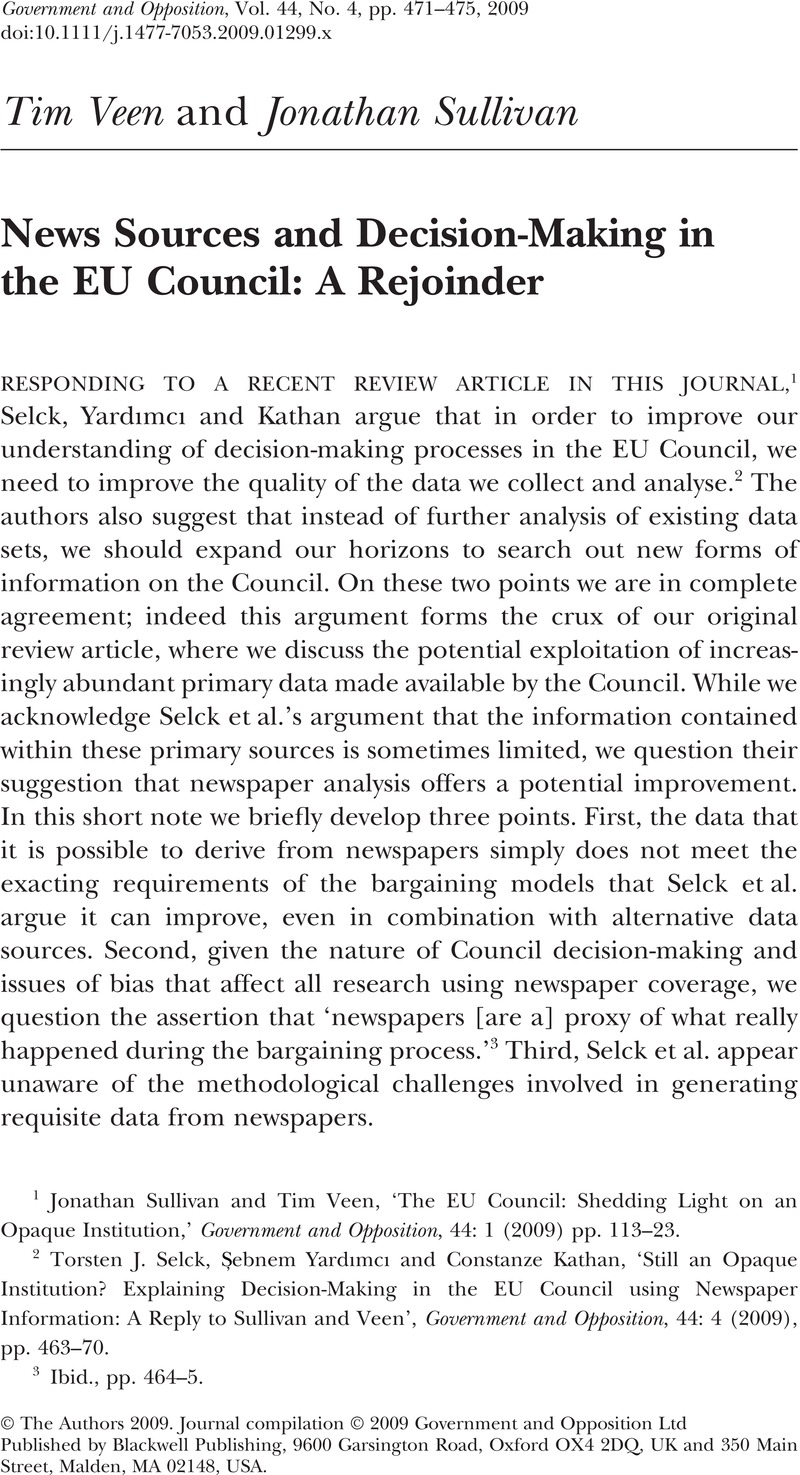Article contents
News Sources and Decision-Making in the EU Council: A Rejoinder
Published online by Cambridge University Press: 02 January 2013
Abstract

- Type
- Articles
- Information
- Copyright
- Copyright © The Author(s) 2009.
References
1 Sullivan, Jonathan and Veen, Tim, ‘The EU Council: Shedding Light on an Opaque Institution,’ Government and Opposition, 44: 1 (2009) pp. 113–23.CrossRefGoogle Scholar
2 Selck, Torsten J., Șebnem Yardımcı and Kathan, Constanze, ‘Still an Opaque Institution? Explaining Decision-Making in the EU Council using Newspaper Information: A Reply to Sullivan and Veen’, Government and Opposition, 44: 4 (2009), pp. 463–70.CrossRefGoogle Scholar
3 Ibid., pp. 464–5.Google Scholar
4 Ibid., p. 470.Google Scholar
5 Ibid., p. 468.Google Scholar
6 Achen, Christopher H., ‘Institutional Realism and Bargaining Models’, in Thomson, Robert, Stokman, Frans N., Achen, Christopher H. and König, Thomas (eds), The European Union Decides, Cambridge, Cambridge University Press, 2006, pp. 86–123.CrossRefGoogle Scholar
7 Ibid.Google Scholar
8 Azar, Edward E., ‘Conflict Escalation and Conflict Reduction in an International Crisis: Suez, 1956’, Journal of Conflict Resolution, 16: 2 (1972), pp. 183–201;CrossRefGoogle Scholar
9 Selck et al., ‘Still an Opaque Institution?’, p. 468.Google Scholar
10 Robert Thomson, ‘Appendix II: Comparison of Expert Judgements with Each Other and with Information from Council Documentation’, in Thomson et al., The European Union Decides, pp. 329–47.Google Scholar
11 Woolley, John T., ‘Using Media-Based Data in Studies of Politics’, American Journal of Political Science, 44: 1 (2000), pp. 156–73, p. 158.CrossRefGoogle ScholarFor an empirical example see Daniel J. Myers and Beth Schaefer Caniglia, ‘All the Rioting That's Fit to Print: Selection Effects in National Newspaper Coverage of Civil Disorders, 1968–1969’, American Sociological Review, 69: 4 (2004), pp. 519–43.
12 Trenz, Hans-Jörg, ‘Media Coverage of European Governance: Exploring the European Public Sphere in National Quality Newspapers’, European Journal of Communication, 19: 3 (2004), pp. 291–319;CrossRefGoogle Scholar Christina Holtz-Bacha, Medienpolitik für Europa, Wiesbaden, VS-Verlag für Sozialwissenschaften, 2006.
13 Selck et al., ‘Still an Opaque Institution?’, p. 467.Google Scholar
14 Ortiz, David G., Myers, Daniel J., Walls, Eugene N. and Diaz, Maria-Elena D., ‘Where Do We Stand with Newspaper Data?’, Mobilization: An International Journal, 19: 3 (2005), pp. 397–419.Google Scholar
15 Selck et al., ‘Still an Opaque Institution?’, p. 467. We take this to mean computer-assisted content analysis.Google Scholar
16 Ibid., p. 469. In reality, however, the information is insufficient in scope and detail to be of much use in model-testing.Google Scholar
17 Laver, Michael, Benoit, Ken and Garry, John, ‘Extracting Policy Positions from Political Texts using Words as Data’, American Political Science Review, 97: 2 (2003), pp. 311–31;CrossRefGoogle Scholar
18 van Atteveldt et al., ‘Good News or Bad News?’.Google Scholar
- 3
- Cited by


